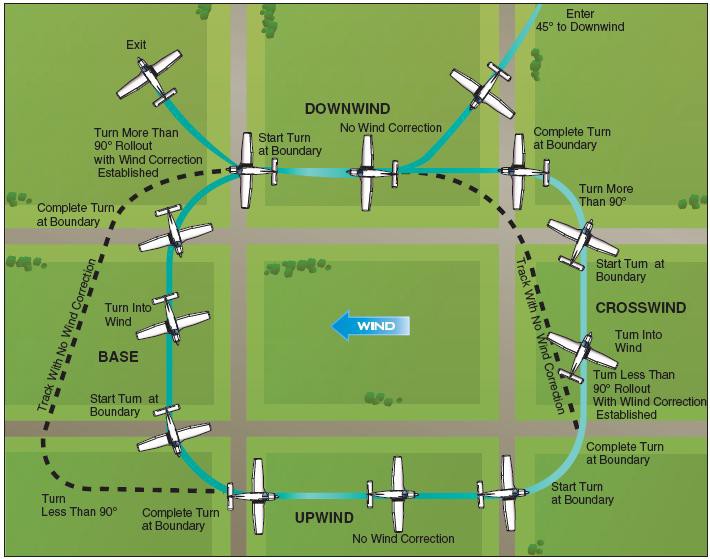In this lesson you will practice normal take-off, normal landing and circuit pattern procedures. By the end of the next few lessons, you should be able to take-off and land the aircraft with minimal assistance from the instructor.
Planned Activities
• Exercises 16, 17 and 18
Reference Material
• FTM
• Pilot Operating Handbook
• AIM
• Ground School and PGI Notes
• CFS
Preparation
• Review FTM on how to judge your approach path and fly a proper circuit pattern.
• Review the circuit information circuit patterns and noise abatement procedures at your airport.
• Know the correct procedures for leaving and joining the circuit at your airport.
• Know the flap extension speeds and circuit speeds for the aircraft.
• Know the After Take-off and Before Landing checklist for your aircraft.
• Review the radio calls required in the circuit.
• Be able to answer the following questions:
1. What is a standard circuit pattern and where can we find this information?
2. Are there right hand circuit patterns at your airport? Why is that?
3. Define the different legs of a circuit?
4. What is a definition of a stabilized approach?
5. How do flaps affect your approach path?
6. What are some reasons to execute a go around?
• Write down your questions!
Tips/Rules of Thumb/Theory
• Proper spacing for the downwind leg is approximately 1/2 of a mile from the runway itself (roughly half the wing strut). Spacing depends on aircraft type.
• Pick geographic landmarks that can help you fly straight legs. Do not fly headings in the circuit, fly tracks.
• If you extend your downwind leg because of traffic spacing, manage your power setting on base leg to prevent a low/shallow approach.
• Turn only when you have the aircraft ahead of you off your left wingtip and flying in the opposite direction for a left hand circuit pattern and vice versa.
• Remember that the power settings mentioned on the FTM are a guides only! They will vary with the weather conditions and engine performance.
• Use the runway numbers to determine whether you are high, low or on the approach path.
• Use pitch control to maintain airspeed and power to control the rate of descent.
• Anytime you have developed an unstable approach, flare or landing (i.e. balloon or bounce), you should attempt a go around.
• Be vigilant about the traffic in the circuit. Do not get too focused inside the cockpit completing all the checks.
Compensating for Wind

Abnormalities in the Circuit
In this lesson you will practice simulated engine failures in the circuit and how to accomplish a safe landing. You will also practice more runway changes, communication failures and go around.
Planned Activities
• Exercises 16, 17, 18 and 29
Reference Material
• FTM
• Pilot Operating Handbook
• AIM
• Ground School and PGI Notes
• CFS
Preparation
• Review FTM on how to judge your glide path and flying proper circuit pattern.
• Review the circuit information circuit patterns and noise abatement procedures at your airport.
• Study the correct procedures for leaving and joining the circuit at your airport.
• Know the After Take-off and Before Landing checklist for our aircraft.
• Review the radio calls required in the circuit.
• Review the crosswind techniques learned in previous lessons.
• Be able to answer the following questions:
1. How do you know if you are on the approach path?
2. What are some factors that affect your approach path?
3. When should you complete the Before Landing checklist?
4. What are your immediate actions if the engine fails while flying in different parts of the circuit? After t/o? Turning base?
5. How do complete a runway change at an uncontrolled airport? What can cause a runway change?
6. If your radio fails while at an uncontrolled airport, what should you do? If it is a controlled airport?
7. What if your com fails and you have a transponder? What should you set it to? Do you always need to set that code?
• Write down your questions!
Tips/Rules of Thumb/Theory
• When an engine failure occurs, your priority is to fly the airplane then worry about the checklists.
• Always – Aviate Navigate Communicate.
• Don’t select flaps to 30 degrees unless the landing is assured when the engine has failed.
• If you do not like the approach or landing—-GO AROUND!
• Be vigilant about the traffic in the circuit. Don’t get too focused inside the cockpit completing all the checks.
All of this information on pilot training and flight training in Canada is also available at www.flighttrainers.ca.